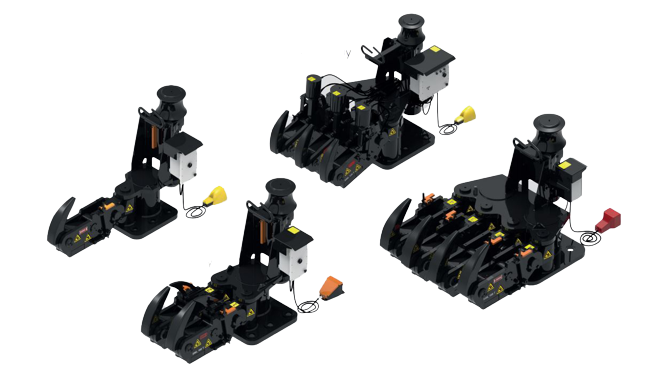Quick Release Mooring Hooks: Benefits
Introduction
Quick release mooring hooks (QRMH) are the basis of all modern and advanced integrated mooring systems. They allow both to quickly secure a vessel to a berth with minimum effort, and to release it quickly and easily, both in normal and emergency operations. That is why they are vital for safety and efficiency in ports. In an emergency, the quick release mooring hook can disconnect the tanker's mooring lines with minimal effort, even under fully loaded conditions. This limits damage to the quay and the environment. Resetting the mooring hook to operational status requires a simple action.
Improved safety
When talking about a quick release hook, safety is the main advantage that comes to mind. But what does this safety specifically entail?
- It protects the vesselby securing the berth, as it is designed to withstand harsh marine environments.
In addition, the quick release hook system also protects the ship from damage to the mooring elements due to excessive tension, if equipped with a tension control system on the hooks. - Protects the port infrastructure, avoiding collisions.
- Protects cargo, avoiding sudden movements, falls and displacements.
- Protects port personnel, as vessels can be released quickly with minimal effort and, therefore, with less likelihood of musculoskeletal injuries.
It also protects them from damage while picking up the end of the line, if they are equipped with a winch for this purpose. - Last but not least, a quick release hook also protects the crew by ensuring a fast and reliable berthing.
Another important advantage of quick release hooks is their ease of installation and handling. In addition, they have a wide range of movement, both horizontally and vertically, which provides a long service life and low maintenance.
This means that the use of quick release hooks is advantageous on any type of quay, from containers and general cargo to oil and gas terminals, LNG and offshore platforms.
Configurations

There are different types of quick release hooks. There are single, double, triple, quadruple or sextuple configurations, depending on the number of nails. The load capacity of the hook can range from 40t to 200t. They can operate at 180° horizontally and 45° vertically. Resetting the lashing hook to operational status requires a simple action, even at full safe working load. Our quick release lashing hooks are individually tested to 150% of the safe working load, have a low total cost of ownership and a proven long service life.
We can find quick release hooks with different options, such as integrated winch, mooring tension control system and automatic release system by remote control. These types of options depend on the type of terminal and the types of vessels and cargoes to be handled.
Optional features of the quick release mooring hook:
- Integrated winches
- Remote control system
- Mooring load control system
- Electrical isolation
- Dust protection covers
- Rope anti-slip devices
- Special coatings
- Special low temperature executions
- Custom designs
Special configurations:
- Set of sextuple hooks
- Back to back mounting
- Quick release lanyard pulley
- Breakaway bolt construction
- Special base plate for installation on existing anchor bolts.
- Special hooks adapted for installation on existing assemblies.
Safe monitoring with the Mooring Load Monitoring System (MLMS)
With the lashing load monitoring system, a close and constant surveillance of the forces on the lashing lines is maintained. Immediate action can be taken in possible slackening or overloading situations. Load information is displayed in real time and alarms can be preset according to safe working load requirements.
With the data obtained, the number of mooring lines required for safe mooring can be estimated. This information is accessible through various handheld devices such as PDA's and pagers.
In case of emergency, the hooks can be released remotely by means of a remote control. With the remote control system, the hooks can be released individually or simultaneously. Hook open or closed indications can be transmitted to the remote control panel or displayed in the iMoor application software. We offer two remote control systems:
- Remote control system electric: The mooring hook release mechanism will be operated by an electric solenoid mounted on the hook
- Remote control system hydraulic: El mecanismo de liberación del gancho es operado por un cilindro hidráulico montado en el gancho. La presión hidráulica es proporcionada por una central hidráulica instalada en cada unidad de amarre.
Both systems are operated by a remote control panel. There are several configurations inside and outside, including push button panels, virtual panels on the computer screen and ATEX certified panels. These panels are explosion-proof.
Conclusion
It is essential that port operators use quality quick release hooks that have been designed and calculated under the most demanding mooring line load assumptions and have passed all performance tests. This is important, because tens of millions of dollars worth of vessels and cargo, not to mention crew safety, depend on the performance of the quick release hooks.
We design and install quick release mooring hooks that have been proven in multiple ports around the world. We offer full service support, from commissioning to installation and maintenance. This means that not only do we offer our catalog of quick release hooks, but we can also make special configurations tailored to our customers' needs.
If you have any questions, please contact us via contact form, or our datasheet. We will be glad to help you.
